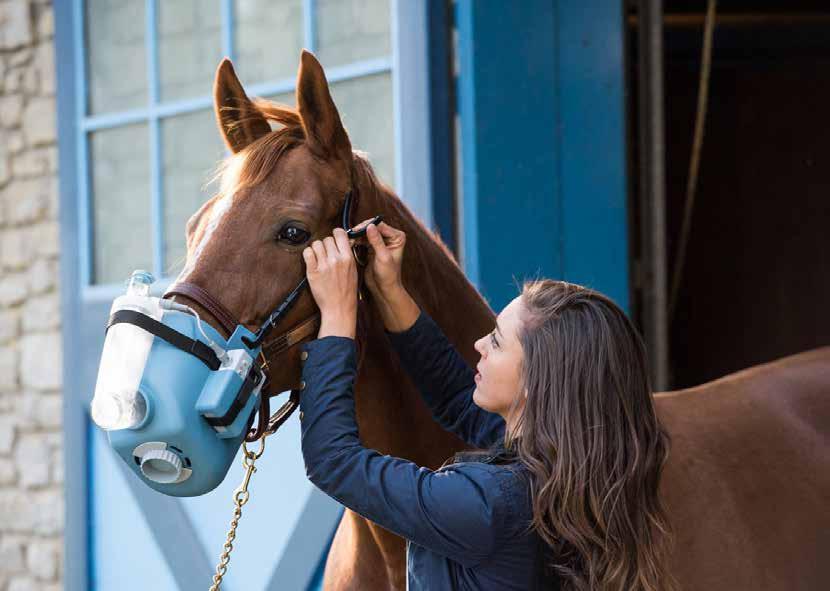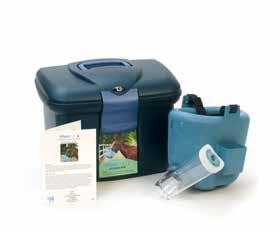
4 minute read
EQUINE RESPIRATORY DISEASE
Equine Respiratory diseases combined, are the number one athletic performance inhibitor in Equine competition, both professional and amateur. Respiratory diseases are both a common and a serious problem and can affect both the youngest and oldest horses, with some of the diseases having high mortality rates.
Advertisement
The most important function of the respiratory system is to deliver oxygen to the blood and remove carbon dioxide. The blood distributes oxygen to the body and collects carbon dioxide, the waste product of cell metabolism. This exchange of oxygen and carbon dioxide occurs in the alveoli and when the exchange fails, or becomes in

efficient because of disease, horses can become seriously ill. If the level of oxygen in the blood is too low (called hypoxia or anoxia), the animal will show signs of respiratory distress.
Respiratory diseases are typically divided into conditions affecting the lower (i.e. the lungs) respiratory tract and the upper (i.e. the nose, throat and trachea) respiratory tract. These diseases can be chronic, short lasting, infectious and hard to diagnose. COMMON SIGNS OF RESPIRATORY DISORDERS - Discharge from the nose (mucus, pus or blood, depending on the cause) - Coughing, that may be dry or include mucus or blood - Rapid breathing while at rest - Laboured or difficult breathing; shortness of breath - Shallow breathing - Signs of pain associated with breathing in or our - Noise (such as grunting) associated with breathing - Head shaking or abnormal carriage of head (low or extended)
HOW DO I KNOW IF MY HORSE HAS A LUNG OR AIRWAY DISORDER? When it comes to diagnosing respiratory disorders in horses, the first port of call is to approach your veterinarian for a physical examination of your horse. This will help to determine the possible cause and site of respiratory disease (upper or lower respiratory tract).
Techniques used for diagnosis include x rays of the chest or neck and the use of an endoscope (a small camera and light mounted on the end of flexible tubing) to view the nose, throat, and airways. Examination of the contents of the lung and airways can be obtained through aspiration or retrieval of fluid used to “bathe” the airways.
Respiratory illnesses could include equine asthma (classified as mild to moderate or severe - which was previously referred to as COPD) or exercise-induced pulmonary haemorrhage (EIPH) which occasionally presents with epistaxis (bleeding at the nostrils after exercise).

WHAT CAN I DO TO PREVENT RESPIRATORY DISEASE / AID RECOVERY? Regardless of the type of respiratory disease, environmental factors and supportive care are important to aid recovery. A dust-free, ammonia-free and well ventilated stable environment prevents further damage to the respiratory system. Keep in mind that horses should be removed from the barn before mucking out of boxes and all hay should be wet down or steamed before feeding.
Consider wetting your horses food to avoid dust inhalation during feeding times to help limit further lung irritation. Avoid hay nets and rather feed grass and food off the ground to encourage mucus drainage. Feeding from large round bales is also discouraged as horses tend to put their muzzle into a large area of grass which has the adverse effect from a greater inhalation of dust/mould particles.
Although severe asthma (or COPD) is not curable, it is a manageable disease that depends largely on the effort that is put into improving the air quality of the environment in which your horse is kept.
Therapies can include altering the inhaled air (for example, reducing dust or adding humidity) as well as the use of nebulisers to administer bronchodilators (to help open airways), antibiotics and steroids. Daily nebulisation of saline has proven to be an effective tool in preventing inflammation in the lungs and airways.
EQUINE NEBULISATION Equine nebulisers, such as the Flexineb E3 from Nortev in Ireland, are designed to aerosolize a wide range of drugs including Silver, Corticosteroids, Eucalyptus oil, Bronchodilators, Saline and, if needed, Antibiotics. Flexineb has been developed to deliver optimum particle size to the lungs with Scintigraphy studies showing that 71% of the nebulized drug is delivered to the lower airways, with the remaining 29% in to the upper airways and trachea.
The Flexineb Equine Nebulisers are portable and silent, making them ideal for use anywhere, any time. The mask is placed comfortably above the horses’ nostrils and the medication is inhaled in each breath taken by the horse and subsequently drawn right down to where the oxygen is transferred into the bloodstream. With the use of nebulisers and face masks, the medication is very effectively delivered to where it is needed. Thus, vets are able to use very accurate and high doses of a specific medication without burdening the rest of the body with such doses. The medicine “hits the spot” without having to pass through all organs of the body.
Flexineb E3 nebulisers are available for purchase and hire within South Africa.
For more information on nebulisation please contact:
Danielle Brown Flexineb RSA 082 415 3892 Email: Flexineb.rsa@gmail.com










